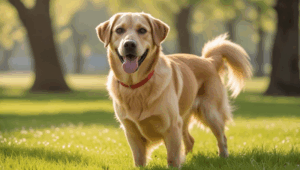Origins and History of the Labrador Retriever
Origin of Labrador
Despite their name, the Labrador Retriever didn’t actually come from Labrador. Instead, their roots trace back to Newfoundland, Canada, where they were known as St. John’s Water Dogs. These hardworking dogs helped fishermen retrieve nets and catch fish from icy waters. Their thick, water-resistant coats and strong, otter-like tails made them the perfect companions for cold, wet environments. This surprising origin story is one of the lesser-known Labrador Retriever facts that many people get wrong.
History of Labrador Retriever
In the 1800s, English nobles visiting Canada were so impressed by the breed’s work ethic and gentle temperament that they brought some dogs back to England. There, Labs were refined by crossing with other hunting breeds, leading to the modern Labrador Retriever we know today. Over time, Labs became prized hunting dogs, reliable field companions, and, eventually, beloved family pets worldwide.
You know what’s funny? Some folks think Labs are from Labrador because of the name, but really, their journey started further south, and their story is proof that great things can come from humble beginnings.
Labrador Retriever Physical Traits and Temperament
When it comes to labrador retriever breed info, this section will cover all you need to know about Labradors’ looks and their world-famous temperament.
| Trait | Description |
| Weight | 55–80 lbs (25–36 kg) |
| Height | 21.5–24.5 inches (55–62 cm) at the shoulder |
| Breed Group | Sporting |
| Coat | Short, dense, water-resistant double coat |
| Colors | Black, yellow, chocolate |
| Shed Level | High |
| Eyes | Friendly and expressive, usually brown or hazel |
| Temperament | Friendly |
| Energy Level | Active |
| Common Health Concerns | hip dysplasia, heart problems, cancer, Ear infections |
| Life Span | 11-13 Years |
Physical traits can vary slightly among black, yellow, and chocolate Labs, but their core characteristics are shared across all varieties. These physical traits and personality characteristics are just the beginning there’s so much more to learn in our complete list of Labrador Retriever Facts below.
100 Essential Labrador Retriever Facts You Should Know
Here are 100 Labrador Retriever Facts, covering everything from fun trivia to essential breed info. This comprehensive list is perfect for new owners and lifelong fans alike.
- Labradors have been the #1 dog breed in America according to the American Kennel Club for over 30 years (AKC).
- Labradors originated from Newfoundland, Canada, not Labrador.
- They were first bred to help fishermen retrieve nets from icy waters.
- Labs are excellent swimmers, thanks to their water-resistant coats and webbed feet.
- Three standard coat colors: black, yellow, and chocolate.
- They have a friendly, outgoing personality.
- Labradors are America’s most popular dog breed.
- Their “otter tail” is thick and helps them steer while swimming.
- Labradors are known for their intelligence and trainability.
- They are often used as guide dogs and service animals.
- Labs have a strong retrieving instinct, making them great at fetch.
- They are gentle and patient with children.
- Labradors shed year-round, especially in spring and fall.
- They love food and can be prone to obesity if overfed.
- Labs are highly social and dislike being left alone for long.
- Labrador Retrievers adapt well to various living environments.
- The breed was officially recognized by the AKC in 1917.
- They typically live 10-12 years.
- Labradors are prone to hip and elbow dysplasia.
- They have a keen sense of smell, used in detection work.
- Labs are often therapy and emotional support animals.
- Black was the original and most common Lab color.
- Chocolate Labs were once considered rare.
- Yellow Labs can range from pale cream to fox red.
- Labs require plenty of exercise at least an hour a day.
- They love water and will swim at any opportunity.
- Labradors do well in dog sports like agility and obedience.
- They have a double coat that repels water and insulates them.
- Labs are not natural guard dogs, but will alert you to strangers.
- Puppies are born with blue eyes that change as they grow.
- Labrador puppies are playful and energetic.
- They are known for their “soft mouth” gentle when carrying objects.
- Labradors are used for search and rescue missions.
- They are among the easiest breeds to train.
- Labs are known for greeting people with enthusiastic tail wags.
- The breed’s ancestors are the St. John’s water dog.
- Labradors have been featured in many movies and TV shows.
- They often bond closely with all family members.
- Labs are generally tolerant of other pets.
- They need regular grooming to manage shedding.
- Labradors can be mouthy as puppies training curbs this habit.
- Their friendly nature makes them poor guard dogs.
- Labs can be prone to ear infections due to floppy ears.
- They are used by law enforcement for detection work.
- Labradors have a reputation for being “foodies.”
- Labs are often used as diabetic alert dogs.
- They are known for their loyalty and companionship.
- Labs can live happily in both city and country homes.
- They are quick to learn commands and tricks.
- Labradors enjoy mental puzzles and games.
- The oldest recorded Lab lived to be 27 years old.
- Labs are prone to shedding, so regular brushing is a must.
- They are known for their expressive, soulful eyes.
- Labradors love to carry things in their mouths.
- Regular exercise helps prevent destructive behavior.
- Labs have a high pain tolerance, which can hide injuries.
- Labrador puppies are born in litters of 6-8 on average.
- Labradors can work as bomb or drug detection dogs.
- They are often used as assistance dogs for the disabled.
- Labradors can become overweight if not exercised properly.
- They are generally good with strangers.
- Labs can have a mischievous streak if bored.
- They are known for their even temperament.
- Labradors have been bred with other breeds to create mixes like the Goldador and Labradoodle.
- They enjoy outdoor adventures and hiking.
- Labradors can be trained for competitive dog sports.
- They are one of the top breeds for first-time dog owners.
- Labs thrive on positive reinforcement training.
- They are gentle and patient with the elderly.
- Labrador fur can be found everywhere during shedding season.
- They can be prone to allergies and skin issues.
- Labs have a strong desire to please their owners.
- Labradors are often the stars of dog shows and competitions.
- They love interactive toys and games.
- Labradors have a sturdy and muscular build.
- They are adaptable to different climates.
- Labs are known for being “velcro dogs”, they stick close to their people.
- They can be a bit clumsy as puppies.
- Labradors are great motivators for an active lifestyle.
- They rarely show aggression when properly socialized.
- Labs are often used as therapy dogs in hospitals and schools.
- They are not known for excessive barking.
- Labradors have a large appetite portion control is important!
- They enjoy traveling and exploring new places.
- Labradors are quick to forgive and forget.
- They have a dense undercoat that keeps them warm in cold water.
- Labs make excellent jogging or walking partners.
- They are often chosen as mascots for organizations and sports teams.
- Labradors can be trained for advanced trick dog titles.
- They have a playful spirit, even into old age.
- Labs are known for their incredible sense of smell.
- They are often featured in family-friendly advertisements.
- Labrador puppies are especially curious and adventurous.
- Labradors have a strong prey drive, especially around birds.
- They benefit from early socialization with other dogs and people.
- Labs are easy to house-train with consistency and patience.
- They are recognized for their “gentle giant” reputation.
- Labradors make loyal and loving companions for life.
- They are among the best breeds for active families.
- Labradors have inspired countless works of art and stories.
- They love belly rubs and cuddles.
- Labs are always up for a game of fetch.
Labrador Retriever Color Variations
Labrador Retrievers come in a variety of beautiful coat colors like yellow, fox red and chocolate. For a deeper understanding of these color variations and what they mean, check out our article on Labrador Colors.
Chocolate Lab Facts and Information

Chocolate Labradors are one of the three recognized Lab colors and are prized for their rich, glossy brown coats and friendly personalities. While black Labs were once the most common, chocolate Labs have become increasingly popular among families and dog lovers.
- Origins: Chocolate Labs were historically rare, often considered less desirable for hunting due to their color. Today, they are beloved family pets and companions.
- Color Genetics: Their chocolate hue comes from a recessive gene. Two Labs carrying this gene are needed to produce chocolate puppies.
- Personality: Chocolate Labs are energetic, affectionate, and outgoing. They tend to be playful and bond closely with their families.
Here are some interesting chocolate labrador retriever facts to know:
- Chocolate Labs can have amber or hazel eyes, which stand out against their dark coats.
- They need plenty of exercise to stay healthy and happy.
- Regular grooming helps their shiny coats stay beautiful and healthy.
- Like other Labs, they can be prone to hip dysplasia and ear infections.
According to Cornell University, all Labradors, regardless of color, share similar health, intelligence, and temperament traits.
Yellow Lab and Fox Red Lab Facts

Yellow Labradors are among the most popular family dogs due to their cheerful appearance and loving nature. Interestingly, yellow Labs come in a wide range of shades, from pale cream to a rich, deep “fox red.” Fox Red Labs are not a separate breed, but rather a darker shade of yellow recognized by many Lab enthusiasts.
- Color Variety: Yellow Labs can be almost white, light gold, or the distinctive fox red.
- Temperament: Like all Labs, yellow varieties are friendly, eager to please, and wonderful with children.
- Fox Red Labs: These Labs are prized for their unique color and are sometimes mistaken for a different breed.
Fun facts about yellow labs and fox red labrador retriever facts include:
- Yellow Labs are frequently chosen as guide dogs due to their calm demeanor.
- Fox Red Labs have been popular in hunting circles for decades.
- Their nose and eye color can vary, with some having brown or black noses and lighter or darker eyes.
Labrador Puppy Facts: What You Need to Know

Labrador puppies are bundles of energy and joy. If you’re considering bringing a Lab puppy home, here are some essential facts about lab puppies and what to expect:
| Age | Development Stage |
| 0-8 weeks | With mom and littermates, learning social skills |
| 8-12 weeks | Ready to join new families, start basic training |
| 3-6 months | Rapid growth, teething, high curiosity |
| 6-12 months | Adolescence, testing boundaries, lots of play |
- Labrador puppies are highly curious and need safe spaces to explore.
- Early socialization is crucial for a well-adjusted adult dog.
- Puppies are “mouthy”, they explore the world with their mouths, so chew toys are a must.
- Labrador retriever puppy facts show that Labs are quick learners but need consistent, positive training.
- Puppies should begin basic obedience, like sit, stay, and come, as soon as possible.
For more information about labrador puppies and their feeding schedule at every age, check out our full guide on Labrador Feeding Guide.
Fun and Interesting Labrador Retriever Facts
Labs are full of surprises and fascinating traits. Here are some fun facts about labrador retrievers and interesting facts about labrador dogs that delight Lab lovers of all ages:
- Labs have webbed feet that make them powerful swimmers, this is one reason they excel at water sports.
- They are sometimes called “gentle giants” for their size and sweet nature.
- Labradors can learn over 200 words and commands, making them one of the smartest breeds.
- They hold the record as the most popular breed in America for over 30 years.
- Labs love to carry things in their mouths, slippers, toys, or even the TV remote!
- They have been featured in many movies, including “Old Yeller,” “Marley & Me,” and “Homeward Bound.”
- Labs are loyal to a fault and often follow their owners from room to room.
- According to the American Kennel Club, Labs are among the best breeds for first-time dog owners.
- Some Labs have worked as search-and-rescue dogs, police K9s, and military service dogs.
- Fun facts about black labs: Black Labs were the original Lab color and are still the most common in working lines.
- Every Lab is unique, some love to swim, others prefer to run, and some are champion couch potatoes.
- Labradors are fantastic with kids and make great therapy and emotional support animals.
- Labs love to eat and can be quite inventive in finding food, so “Lab-proofing” your kitchen is a must!
- They rarely show aggression and are known for their patience and forgiving nature.
- Labs are often called “velcro dogs” because of how closely they stick to their families.
- They require at least 60 minutes of exercise daily to stay healthy and happy.
- Labradors shed year-round, especially in spring and fall regular brushing helps manage this.
- They are often used as guide dogs for the visually impaired, thanks to their intelligence and calmness.
- Labs play a starring role in many heartwarming rescue stories around the world.
- Black, yellow, and chocolate puppies can be born in the same litter.
- Labs are famous for their scent detection skills and often work in police, military, and rescue roles.
- Labs are notorious for eating almost anything, sometimes even socks!
- Labs stay puppy-like until age three (sometimes longer!), making training and patience essential.
- Some Labs have won awards for saving lives, like Endal, who helped his disabled owner in an emergency.
These fun and interesting Labrador Retriever Facts showcase just how amazing this breed truly is.
Labrador Retriever Facts of Mixed Breeds: Goldador, Golden Labs, and More

Labrador Retrievers are often crossed with other breeds to create unique and versatile mixes. These mixes often combine the best traits of the Lab with those of another friendly dog breed. Here are some popular Labrador Retriever breed mixes and their key facts:
| Mix | Description |
| Goldador | Golden Retriever + Labrador. Friendly, easy to train, and great for families and service work. |
| Labradoodle | Poodle + Lab. Hypoallergenic potential, very intelligent, loves to play. |
| Sheprador | German Shepherd + Lab. Loyal, protective, and energetic. |
| Labmaraner | Weimaraner + Lab. Athletic, intelligent, needs lots of exercise. |
- Goldador facts: This mix is especially popular for therapy and assistance dog work due to their gentle nature.
- Golden Lab facts: These dogs are affectionate and eager to please, making them great for active families.
- Labrador mixes often inherit the Lab’s outgoing personality and trainability.
- Exercise needs can be high in mixes, daily play and walks are a must!
If you’re considering adopting a Lab mix, research the other breed’s traits to ensure a good fit for your lifestyle.
Want to keep your Lab healthy and happy? Check out our guide on Labrador Retriever Health Issues to understand the common problems and how to prevent them.
Frequently Asked Questions About Labrador Retriever Facts
What are the three main colors of Labrador Retrievers?
According to the many labrador retriever facts, the three recognized Lab colors are black, yellow (which includes fox red), and chocolate. Each color shares the same great Lab temperament and intelligence.
How long do Labrador Retrievers live?
Labradors typically live between 10-12 years. With good nutrition, exercise, and regular vet care, some Labs live even longer.
Are Labradors good with children and other pets?
Yes! One of the best-known Labrador Retriever facts is how great they are with children and other pets. Their gentle, patient, and playful, making them excellent family pets. They usually get along well with other dogs and animals, especially when socialized early.
How much exercise does a Labrador need?
Labradors are active dogs who need at least one hour of exercise each day. This includes walks, games of fetch, swimming, or dog sports. Exercise helps prevent boredom and weight gain.
Do Labrador Retrievers shed?
Yes, Labs shed year-round, with heavier shedding in spring and fall. Regular brushing helps manage loose fur and keeps their coat healthy.
What health problems are common in Labradors?
Labradors can be prone to hip and elbow dysplasia, obesity, and ear infections. Regular check-ups and a healthy diet can reduce these risks. For more information explore the article on common health problems in labrador.
Can Labradors be left alone during the day?
Labs are social and may become anxious if left alone for long periods. If you must leave your Lab, provide toys and enrichment, and try not to leave them alone for more than a few hours at a time.
Are there differences in personality between black, yellow, and chocolate Labs?
All Labs share the same core traits: friendly, energetic, and loving. Some owners believe chocolate Labs are more playful, but science shows these differences are mostly individual, not color-based.
How big do Labradors get?
Adult males usually weigh 65–80 lbs; females, 55–70 lbs. Height ranges from 21.5–24.5 inches at the shoulder.
Are Labradors easy to train?
Yes, Labradors are among the easiest breeds to train. They respond well to positive reinforcement and love learning new tricks. Consistency is key!
Conclusion: Everything You Need to Know About Labradors
Labrador Retrievers are truly one-of-a-kind dogs, prized for their intelligence, loyalty, and boundless affection. Whether you’re drawn to a black Lab’s classic look, a chocolate Lab’s rich color, or a yellow or fox red Lab’s sunny personality, you’ll find a loyal friend in this breed.
From chocolate labrador retriever facts to fun facts about black labs, one thing is clear: Labs are adaptable, smart, and eager to be part of the family. Their playful spirit, love for adventure, and gentle hearts make them favorites worldwide.



